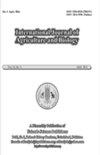Review on Genomics, Production Potential and Usefulness of Camel as the Animal of Future
Q2 Agricultural and Biological Sciences
引用次数: 0
Abstract
Food security issues are persistently emerging in proportionate to the growth of human population. This scenario demands a search for alternate and development of new food sources. Camel can therefore be the best alternative and beneficial addition to food supply chain providing milk and meat for humans. It is an imperative component of desert ecosystem with much better feed conversion ratio. Hence in arid zones, it provides more milk and meat with less consumption of feed and fodder. Moreover, Heat Shock proteins present in camel serve as molecular chaperones and strengthen its resistance capability against hostile desert environment ultimately facilitating its survival. Distinctive nutritional value of its milk is thought to have therapeutic attributes. Furthermore, camel milk inherently possesses antimicrobial agents which promote its antiviral and antibacterial capacity. Its unique adaptability and superiority over other livestock has compelled scientists for the last few decades to explore its hidden potential. Its proper breeding and farming infrastructure, well backed by scientific advancements, does not exist which need to be essentially developed and established, the initiative not possible without collaborative research efforts. Under present conditions and keeping in view the requirements of the masses, the investigative work should focus on its therapeutic, biological, and functional properties instead of pursuing trivial aspects. Successful management and efficient handling of these researchable avenues can facility efficient utilization of this animal to meet the ever-increasing food demands of the masses. This review article will highlight its wonderful adaptive features, genetic make-up, usefulness at present, and its potential for future food security. © 2022 Friends Science Publishers骆驼作为未来动物的基因组学、生产潜力和用途综述
与人口增长成比例的粮食安全问题不断出现。这种情况要求寻找替代和开发新的食物来源。因此,骆驼可以成为为人类提供牛奶和肉类的食品供应链的最佳替代品和有益的补充。它是荒漠生态系统的重要组成部分,具有较好的饲料转化率。因此,在干旱地区,它提供了更多的牛奶和肉类,消耗更少的饲料和饲料。此外,骆驼体内存在的热休克蛋白作为分子伴侣,增强了骆驼对恶劣沙漠环境的抵抗能力,最终促进了骆驼的生存。牛奶独特的营养价值被认为具有治疗作用。此外,骆驼奶本身具有促进其抗病毒和抗菌能力的抗菌剂。它独特的适应性和优于其他牲畜的优势迫使科学家们在过去的几十年里探索它隐藏的潜力。它不存在适当的育种和农业基础设施,这些基础设施得到了科学进步的充分支持,这些基础设施基本上需要发展和建立,没有合作研究努力,该倡议是不可能的。在目前条件下,从群众需求出发,研究工作应着眼于其治疗、生物学和功能特性,而不是追求鸡毛蒜皮的鸡毛蒜皮。成功地管理和有效地处理这些可研究的途径,可以促进这种动物的有效利用,以满足群众日益增长的食物需求。这篇综述文章将重点介绍其奇妙的适应特性、基因组成、目前的用途及其对未来粮食安全的潜力。©2022朋友科学出版社
本文章由计算机程序翻译,如有差异,请以英文原文为准。
求助全文
约1分钟内获得全文
求助全文
来源期刊

International Journal of Agriculture and Biology
AGRICULTURE, MULTIDISCIPLINARY-
CiteScore
1.70
自引率
0.00%
发文量
40
审稿时长
5 months
期刊介绍:
Information not localized
 求助内容:
求助内容: 应助结果提醒方式:
应助结果提醒方式:


